Tartu celebrates 1919 victory in Tähtvere
Description of the Battle of Tähtvere in the Estonian War of Independence in January 1919, during which Estonian troops liberated Tartu from the Red Army.
A description of the Battle of Tähtvere in January 1919, in which the Estonian forces liberated Tartu from the clutches of the Red Army.
The enemy made one last attempt to hold Tartu in the park in Tähtvere, sending Latvian Riflemen reinforcements into combat. The riflemen knew how to utilise the terrain to their advantage, as they were seasoned veterans of World War I. Bullets were fired from every ditch, every bush, every mound, every boulder. The Estonian offensive progressed slowly. Automatic rifles and machine guns were despatched from the armoured trains, which had fallen behind due to railway repairs, to support the front-line troops, but these were of limited help. The battle had raged for more than an hour, but the Latvians were not falling back. They were supported by a 4.5-inch howitzer from the railway station. Many of the Estonian troops had been wounded by this point, Lieutenant Neps among them. To make the most of the situation, privates Selter, Saar, Ringenberg, Sapur and others ran left under fire, surrounding the Red Army Riflemen from the right and opening fire on them and Tähtvere Manor. This tactic led to confusion among the Latvian Reds and the Estonians gained the upper hand. At the same time, the armoured trains, which had just arrived, began firing shrapnel shells at the manor. As the trains drew closer, their machine guns opened fire. This was pivotal. The tables had turned. The Reds quickly retreated from the battle site.
Postman. January 14, 1944. https://dea.digar.ee/article/postimeesew/1944/01/14/13
Related objects
Monument to the Battle of Tähtvere
This monument, designed by Aleksander Eller and commemorating the Estonian victory over the Red Army Latvian Riflemen in the Battle of Tähtvere on 14 January 1919, was unveiled on 3 July 1932. It was demolished in 1940, but restored in 1942. After the war, the Soviet regime had the monument completely destroyed and eventually replaced, in 1957, with a bust of Hans Heidemann, a figure in the workers' and trade union movement. Restoration of the monument was proposed by Enn Tarto, and it was unveiled anew at its original site on 2 July 2006.





